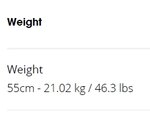I didn't see a thread on this bike, so I thought I'd post one.
Here's the info I've seen so far (on the 8+, is there a 9+ coming?):
Bosch mid drive (Performance Speed)
Motor = Bosch Performance Speed, 250Watt, 75Nm (versus 350W, 60 N-M in the XM)
Range = "at least 30 miles of high speed riding" (compared to 15 with the XM700+)
Top speed = ??? (my bold prediction is it's 20 and not 28 mph. the XM specs say 28 all over but I don't see a speed on the 8+ specs; maybe there will be a 9+ that is a 28 mph model?)
Battery = Bosch Powerpack 500 (vs. 400 on the XM)
Sizing = also weird and looks very large like the XM but there's a smaller size 45 cm that doesn't exist in the XM
Controller = Bosch Purion (vs. Intuvia Performance) (no clue if that's an improvement)
Fork = carbon rigid (vs. the headshock thingy on the XM)
Components mostly Deore/SLX (mostly a step better than XM, although not sure about how brakes or wheels compare)
Tires - much bigger (2.4, which is = 61 mm) (compare to the 38s on the XM)
http://www.trekbikes.com/us/en_US/bikes/city-bikes/electric-city-bikes/super-commuter/c/B449 (avail Spring 2017)
pics here: http://overvolted.com/trek-super-commuter/
https://www.reddit.com/r/ebikes/comments/4vuq7t/trek_announces_new_boschpowered_28mphcapable/
Thoughts? Will this replace or supplement the XM? XM is faster and more powerful, but has a smaller battery and is frankly not nearly as good looking!
Here's the info I've seen so far (on the 8+, is there a 9+ coming?):
Bosch mid drive (Performance Speed)
Motor = Bosch Performance Speed, 250Watt, 75Nm (versus 350W, 60 N-M in the XM)
Range = "at least 30 miles of high speed riding" (compared to 15 with the XM700+)
Top speed = ??? (my bold prediction is it's 20 and not 28 mph. the XM specs say 28 all over but I don't see a speed on the 8+ specs; maybe there will be a 9+ that is a 28 mph model?)
Battery = Bosch Powerpack 500 (vs. 400 on the XM)
Sizing = also weird and looks very large like the XM but there's a smaller size 45 cm that doesn't exist in the XM
Controller = Bosch Purion (vs. Intuvia Performance) (no clue if that's an improvement)
Fork = carbon rigid (vs. the headshock thingy on the XM)
Components mostly Deore/SLX (mostly a step better than XM, although not sure about how brakes or wheels compare)
Tires - much bigger (2.4, which is = 61 mm) (compare to the 38s on the XM)
http://www.trekbikes.com/us/en_US/bikes/city-bikes/electric-city-bikes/super-commuter/c/B449 (avail Spring 2017)
pics here: http://overvolted.com/trek-super-commuter/
https://www.reddit.com/r/ebikes/comments/4vuq7t/trek_announces_new_boschpowered_28mphcapable/
Thoughts? Will this replace or supplement the XM? XM is faster and more powerful, but has a smaller battery and is frankly not nearly as good looking!
